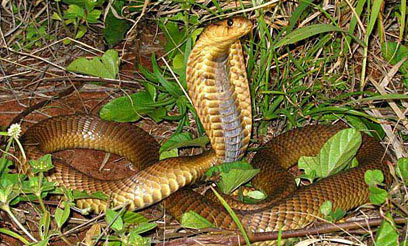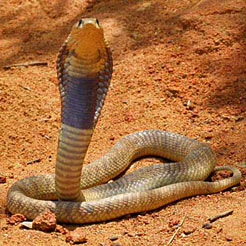|
Naja annulifera (Snouted cobra, Egyptian cobra, Banded cobra)
Wipneuskobra, Bosveldkapel [Afrikaans}; isiKhotsholo [Xhosa];
uPhempethwane [Zulu]; iLoyi [Ndebele]; Masumo [South Sotho]; Mungu [Shona].
Life >
Eukaryotes
>
Opisthokonta >
Metazoa
(animals) > Bilateria > Deuterostomia >
Chordata >
Craniata > Vertebrata (vertebrates) > Gnathostomata (jawed vertebrates) >
Teleostomi (teleost fish) > Osteichthyes (bony fish) > Class:
Sarcopterygii (lobe-finned fish) > Stegocephalia (terrestrial vertebrates) >
Tetrapoda
(four-legged vertebrates) > Reptiliomorpha > Amniota >
Reptilia (reptiles) >
Romeriida > Diapsida > Lepidosauromorpha > Lepidosauria >
Squamata > Serpentes
(snakes) > Family: Elapidae > Genus:
Naja
 |
 |
|
Naja annulifera (Snouted cobra, Egyptian cobra, Banded cobra), KwaZulu-Natal [B. Maritz © from
SARCA
Virtual Museum] |
Naja annulifera (Snouted cobra, Egyptian cobra, Banded cobra), Limpopo [G. Tomsett
© from
SARCA
Virtual Museum] |
Identification
This snake species can be identified by the following
features; a particularly large hood, a dark throat band, its dark brown or blue
black colouration (however some individuals have a banded colouration) and its
habit of basking in close proximity to its retreat. It grows to an average
length of 1.8 meters but can be as long as 2.5 meters in length.
Distribution and habitat
This snake is present in the following areas Limpopo, the
North West, northern Gauteng and northern KwaZulu-Natal. It is also found in southern
Mozambique, eastern Botswana and Zimbabwe. Its favoured habitat includes savanna,
lowveld and bushveld areas. It is also able to climb trees.
Food
Feeds on
toads,
rodents, birds
(especially poultry), other snakes (especially Puff adders).
Predators, parasites and disease
It is fed on by
birds of
prey (particularly
secretary birds and
snake eagles) and other snakes
Reproduction
Oviparous (egg laying), lays between 8 and 33 eggs in early
summer.
Longevity
This cobra species has an average life span of 20 years.
Medical importance
The Snouted cobra has a very powerful and potentially fatal
neurotoxic venom which causes respiratory failure and intense pain in the
affected limb. Luckily an antivenom is available.
Links
References
-
Broadley, D.G. 1983. FitzSimons' Snakes of Southern
Africa. Delta Books, Johannesburg.
-
Marais, J. 2004. A Complete Guide to Snakes of Southern Africa.
Struik Publishing, Cape Town.
|
